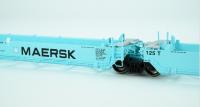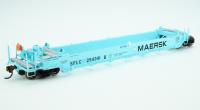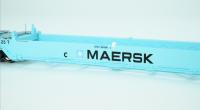Pozoruhodné dárky | Sběratelské předměty | LOKO VAGÓNY WAGONS CARS - MODELY HO a další | SF Leasing (SFLC) / Maersk #3 HO Maxi-I Stack Well Container Car (5-unit) (Early)
SF Leasing (SFLC) / Maersk #3 HO Maxi-I Stack Well Container Car (5-unit) (Early)
| Věkové omezení: | 14 |
| Skladem: | poslední kusy |
| Kategorie: | LOKO VAGÓNY WAGONS CARS - MODELY HO a další |
| Kód: | A37098 |
| Výrobce: | Unspecified |
Cena 9 993,00 Kč s 21% DPH
Sada 5 nákladních vanových plošinových vagónů modelové železnice v měřítku HO pro železniční modeláře v modelářské kvalitě na přepravu kontejnerů - ATH95048 ATHEARN RTR SF Leasing (SFLC) / Maersk #3 HO Maxi-I Stack Well Container Car (5-unit) (Early).
fully assembled and factory finished. separately applied wire grab irons and etched end walkways. separately applied brake piping and trainline hoses. fine ladder detail. delicate cross-bracing on the floor weighted for optimal performance. prototypically correct 33ft and 38ft solid nickel silver wheels with RP25 contours that operate on all popular brands of track. body mounted McHenry lower shelf operating scale knuckle couplers. 18" minimum radius. fits 20ft or 40ft containers in bottom and can accept 45ft and 48ft containers on upper stack position.
A well car, also known as a double-stack car or stack car (also well wagon), is a type of railroad car specially designed to carry intermodal containers (shipping containers) used in intermodal freight transport. The "well" is a depressed section which sits close to the rails between the wheel trucks of the car, allowing a container to be carried lower than on a traditional flatcar. This makes it possible to carry a stack of two containers per unit on railway lines (double-stack rail transport) wherever the loading gauge assures sufficient clearance. The top container is secured to the bottom container either by a bulkhead built into the car (e.g., bottom and top containers are the same dimensions of 40 ft.), or through the use of inter-box connectors (IBC). Four IBCs are needed per wellcar. In the process of an inbound train becoming an outbound train, there are four processes: unlock to unload the top container of inbound train, remove then unload bottom container, insert after loading bottom container of outbound train, lock after top container loaded.
Advantages to using well cars include increased stability due to the lower center of gravity of the load, lower tare weight, and in the case of articulated units, reduced slack action.
Double-stack cars are most common in North America where intermodal traffic is heavy and electrification is less widespread; thus overhead clearances are typically more manageable.
Southern Pacific Railroad (SP), along with Malcom McLean, devised the first double-stack intermodal car in 1977. SP then designed the first car with ACF Industries that same year. At first it was slow to become an industry standard, then in 1984 American President Lines started working with the Thrall Company to develop a refined well car and with the Union Pacific to operate a train service using the new well cars. That same year, the first all "double stack" train left Los Angeles for South Kearny, New Jersey, under the name of "Stacktrain" rail service. Along the way the train transferred from the UP to CNW and then to Conrail.
Each unit of a double-stack car is constructed with a single well, but are often constructed with multiple units of three to five units, connected by articulated connectors. Articulated connectors are supported by the centerplate of a single truck, (often a 125-short-ton, 112-long-ton or 113-tonne capacity truck but sometimes a 150-short-ton, 134-long-ton or 136-tonne capacity one).
Also, in a number of cases, multiple single-well cars (usually 3 or 5) are connected by drawbars and share a single reporting mark.
On both types of multiple-unit cars, the units are typically distinguished by letters, with the unit on one end being the "A" unit, and the unit on the other end being the "B" unit. Middle units are labeled starting with "C", and going up to "E" for five-unit cars starting from the "A" unit and increasing towards the "B" unit.
Double-stack cars come in a number of sizes, related to the standard sizes of the containers they are designed to carry. Well lengths of 40 ft (12.19 m), 48 ft (14.63 m) and 53 ft (16.15 m) are most common. A number of 45 ft (13.72 m) wells and 56 ft (17.07 m) wells also exist. (The sizes of wells are frequently marked in large letters on the sides of cars to assist yard workers in locating suitable equipment for freight loads.)
On 40ft, 45ft, 48ft, or 53ft cars, larger containers (45ft or up) are often placed on top of smaller containers that fit in the available wells to efficiently use all available space. All wells are also capable of carrying two 20 ft ISO containers in the bottom position.
Some double-stack cars have been also equipped with hitches which allow them to carry semi-trailers as well as containers. These are known as "all-purpose" well cars.
Foreign intermodal trains carry 20ft s, 40ft s, 45ft s and 53 foot containers to and from coastal container ports to import or export intercontinentally.
Domestic intermodal trains carry 53 foot containers plus trailer-on-flatcar and they travel throughout North America.
Econo Stack well cars are a variation of conventional well cars and their main purpose is to give the double stacked containers more support. The down side to them is they do not allow 53ft containers to be stacked on top, but 45ft containers still fit and are able to stack on top.
PLEASE NOTE: Due to the small edition size and the great demand for this item, allocations are expected to occur.
UPOZORNĚNÍ: TITUL JE VYROBENÝ V OMEZENÉM MNOŽSTVÍ JAKO UMĚLECKÝ PŘEDMĚT. UVEDENÁ PRODEJNÍ CENA JE PLATNÁ DO VYPRODÁNÍ TUZEMSKÝCH ZÁSOB.
fully assembled and factory finished. separately applied wire grab irons and etched end walkways. separately applied brake piping and trainline hoses. fine ladder detail. delicate cross-bracing on the floor weighted for optimal performance. prototypically correct 33ft and 38ft solid nickel silver wheels with RP25 contours that operate on all popular brands of track. body mounted McHenry lower shelf operating scale knuckle couplers. 18" minimum radius. fits 20ft or 40ft containers in bottom and can accept 45ft and 48ft containers on upper stack position.
A well car, also known as a double-stack car or stack car (also well wagon), is a type of railroad car specially designed to carry intermodal containers (shipping containers) used in intermodal freight transport. The "well" is a depressed section which sits close to the rails between the wheel trucks of the car, allowing a container to be carried lower than on a traditional flatcar. This makes it possible to carry a stack of two containers per unit on railway lines (double-stack rail transport) wherever the loading gauge assures sufficient clearance. The top container is secured to the bottom container either by a bulkhead built into the car (e.g., bottom and top containers are the same dimensions of 40 ft.), or through the use of inter-box connectors (IBC). Four IBCs are needed per wellcar. In the process of an inbound train becoming an outbound train, there are four processes: unlock to unload the top container of inbound train, remove then unload bottom container, insert after loading bottom container of outbound train, lock after top container loaded.
Advantages to using well cars include increased stability due to the lower center of gravity of the load, lower tare weight, and in the case of articulated units, reduced slack action.
Double-stack cars are most common in North America where intermodal traffic is heavy and electrification is less widespread; thus overhead clearances are typically more manageable.
Southern Pacific Railroad (SP), along with Malcom McLean, devised the first double-stack intermodal car in 1977. SP then designed the first car with ACF Industries that same year. At first it was slow to become an industry standard, then in 1984 American President Lines started working with the Thrall Company to develop a refined well car and with the Union Pacific to operate a train service using the new well cars. That same year, the first all "double stack" train left Los Angeles for South Kearny, New Jersey, under the name of "Stacktrain" rail service. Along the way the train transferred from the UP to CNW and then to Conrail.
Each unit of a double-stack car is constructed with a single well, but are often constructed with multiple units of three to five units, connected by articulated connectors. Articulated connectors are supported by the centerplate of a single truck, (often a 125-short-ton, 112-long-ton or 113-tonne capacity truck but sometimes a 150-short-ton, 134-long-ton or 136-tonne capacity one).
Also, in a number of cases, multiple single-well cars (usually 3 or 5) are connected by drawbars and share a single reporting mark.
On both types of multiple-unit cars, the units are typically distinguished by letters, with the unit on one end being the "A" unit, and the unit on the other end being the "B" unit. Middle units are labeled starting with "C", and going up to "E" for five-unit cars starting from the "A" unit and increasing towards the "B" unit.
Double-stack cars come in a number of sizes, related to the standard sizes of the containers they are designed to carry. Well lengths of 40 ft (12.19 m), 48 ft (14.63 m) and 53 ft (16.15 m) are most common. A number of 45 ft (13.72 m) wells and 56 ft (17.07 m) wells also exist. (The sizes of wells are frequently marked in large letters on the sides of cars to assist yard workers in locating suitable equipment for freight loads.)
On 40ft, 45ft, 48ft, or 53ft cars, larger containers (45ft or up) are often placed on top of smaller containers that fit in the available wells to efficiently use all available space. All wells are also capable of carrying two 20 ft ISO containers in the bottom position.
Some double-stack cars have been also equipped with hitches which allow them to carry semi-trailers as well as containers. These are known as "all-purpose" well cars.
Foreign intermodal trains carry 20ft s, 40ft s, 45ft s and 53 foot containers to and from coastal container ports to import or export intercontinentally.
Domestic intermodal trains carry 53 foot containers plus trailer-on-flatcar and they travel throughout North America.
Econo Stack well cars are a variation of conventional well cars and their main purpose is to give the double stacked containers more support. The down side to them is they do not allow 53ft containers to be stacked on top, but 45ft containers still fit and are able to stack on top.
PLEASE NOTE: Due to the small edition size and the great demand for this item, allocations are expected to occur.
UPOZORNĚNÍ: TITUL JE VYROBENÝ V OMEZENÉM MNOŽSTVÍ JAKO UMĚLECKÝ PŘEDMĚT. UVEDENÁ PRODEJNÍ CENA JE PLATNÁ DO VYPRODÁNÍ TUZEMSKÝCH ZÁSOB.
Zaregistrujte k odběru Newsletteru
Pozoruhodné knihy (Nakladatelství Pknihy publishing)
email: info@pknihy.cz
tomindo © 2012-2023, systém TomShop 2.5 | www.pknihy.cz | www.pozoruhodneknihy.cz | www.pozoruhodnedarky.cz





